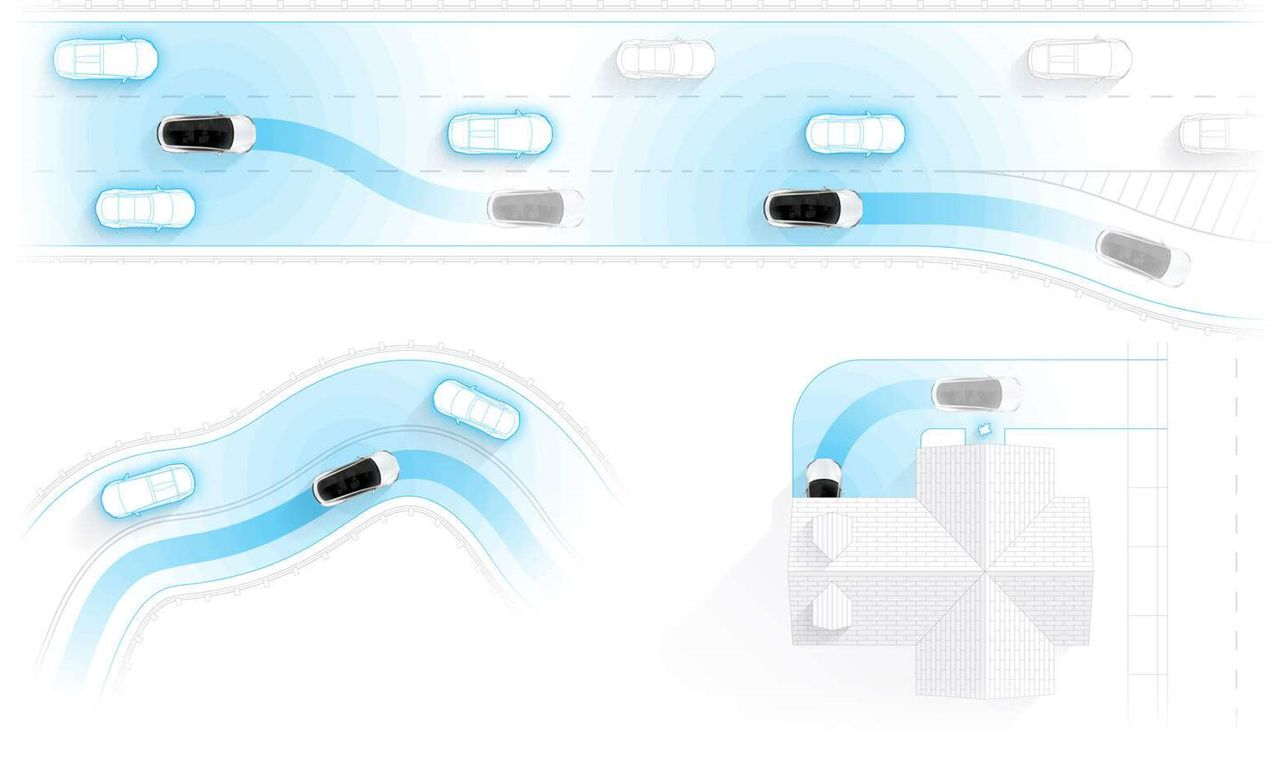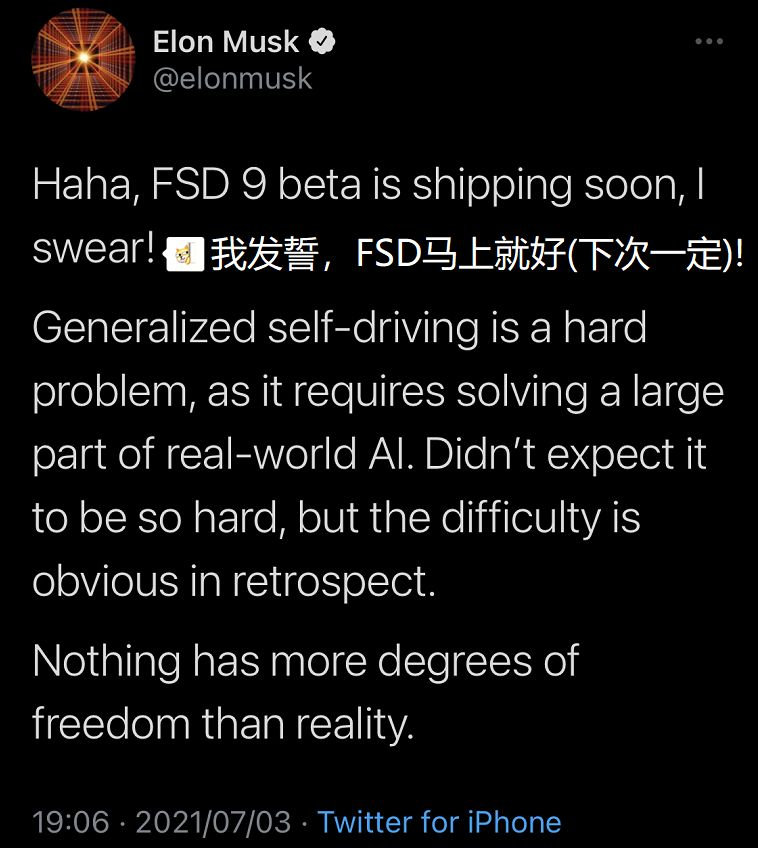Disruptor of Assisted Driving
As a practitioner in the field of autonomous driving, during the first two years of my career, I had a great admiration for Tesla Autopilot’s assisted driving technology. Why?
This is because the use of Tesla’s assisted driving function left me with a deep impression. The simple activation method, excellent cruising and lane keeping ability, and novel shift lever lane changing, one by one simple and easy-to-use, excellent features, continuously overturned my understanding of driving. I had never thought that autonomous driving had become so mature. This was in the era when “new forces had only done well in PPT, and there was no complete vehicle factory that was capable,” which made me realize that having Autopilot in Tesla was definitely a low blow to other automakers’ so-called intelligent cars.
Just as my department was trying to pixel-perfectly replicate Tesla’s Autopilot function, Tesla quietly began to combine navigation maps and Autopilot to launch navigation assisted driving NOA (Navigate On Autopilot), and conducted public testing in the United States in October 2018.
NOA can automatically overtake and change lanes entering and exiting ramps according to the navigation information input by the user, rather than simply cruising. It takes assisted driving to a new level, making it increasingly difficult for followers to keep up with Tesla’s pace. Coupled with the continuously improved autonomous parking/summoning technology, Tesla, with its own efforts, showed the public what a truly intelligent car was.

In the two years after the launch of NOA, Tesla began a more significant engineering project besides some basic bugs and routine updates-FSD (Full Self-Driving). In October 2020, Tesla released their redesigned FSD beta to the public, enabling updated software Tesla to have the ability to automatically drive on roads in city conditions. Although there are still some unresolved issues with FSD beta from the public testing results, and it has been postponed due to these issues, it is undeniable that FSD will be another milestone in Tesla’s assisted driving field.
Tesla is like the 2010 Apple iPhone, providing a template for new entrants and established automakers to follow. Without Tesla’s disruptive influence, the importance placed on assisted driving by automakers globally would have been significantly diminished, and Level 2 assisted driving technology would not be as prevalent as it is today.
It is easy to understand why Tesla’s Model 3 appeals to some young consumers. They vote with their feet and choose the car that best represents “intelligence” in their eyes.
Tesla Model 3 VS XPeng P7
Tesla’s assisted driving has long played the leading role overseas, but progress towards localization in China has not been as encouraging.
In May 2019, NOA was tested in China, and in the following two years, aside from the release of Smart Summon, Tesla has made only minor improvements to its assisted driving capabilities. During this time, domestic new energy vehicle companies, represented by XPeng Motors, have gradually eliminated these gaps, and even surpassed Tesla in terms of user experience.
XPeng P7 and Tesla Model 3 are like two players in a game that continue to fight monsters and level up. These two players can both defeat the ultimate boss (navigation-assisted driving), but their equipment (hardware configuration) and operations (software capabilities) are different.
XPeng P7’s equipment can be described as very luxurious for a production car. It is equipped with an NVIDIA Xavier (30 TOPS of computing power) as the main control chip, which processes data from 14 cameras, 5 millimeter-wave radars (1 long-distance radar + 4 short-range angle radars), and 12 ultrasonic radars. It uses high-precision maps from AMap.
The sensors on the Tesla Model 3 are relatively less luxurious, but it has a main control chip named FSD (with 144 TOPS of computing power) that processes data from 8 cameras, 1 long-distance millimeter-wave radar, and 12 ultrasonic radars. It uses Chinese navigation maps.
To put it simply, XPeng P7 has omniscient eyes and ears, while Tesla may not have that, but it has a smarter brain.### Tesla’s NOA vs XPeng’s NGP
Both Tesla Model 3 and XPeng P7 can achieve assisted driving based on navigation, but their strategies are different.
The logic of NOA in implementing navigation-assisted driving tends to believe in the environment information perceived by itself. This driving strategy is more human-like and has stronger generalization ability. However, in complex scenarios such as poor lighting, disappearing lane markings on the road, overlapping old and new lane markings, and multiple road junctions, the assisted driving system will request the driver to take over, resulting in a slightly worse experience.
The logic of NGP in implementing navigation-assisted driving tends to believe in the road structure provided by high-precision maps for driving. This strategy is similar to that of most mainstream self-driving companies, and its robustness is stronger and not easily affected by weather and lighting. However, if the road structure changes and the high-precision map is not updated in time, there will be a situation of taking the wrong route. However, due to the relatively timely update of map data by domestic map vendors, the probability of such incidents occurring is relatively low.
The NOA function of Model 3 has already achieved remarkable results in terms of experience, but XPeng’s NGP with high-precision maps is more like having a “cheat code,” which makes the experience more worry-free than that of Model 3.
For example, NOA needs the driver to adjust the vehicle speed manually every time it passes from the ramp to the main road, while XPeng automatically adapts to the speed limit according to the section of the road, without the need for driver intervention. Moreover, because NOA uses navigation maps that do not have lane-level road topology, it is easier to take the wrong route at Y-type intersections on elevated connection sections. In comparison, XPeng’s NGP handles these road conditions more elegantly and has been optimized better for domestic road conditions. For example, in the following comparison video test.
The problems with Tesla NOA are mainly reflected in the issue of local adaptation of domestic road conditions.
Different from XPeng’s NGP, both the selection of training data and the design of driving logic are based on domestic road conditions. However, the whole logic design of Tesla NOA system still relies heavily on American training data and road conditions. It is not easy to directly transplant this driving logic. That is why Tesla has set up a local technical team in China.### Tesla Smart Summon vs. Xpeng Valet Parking Assist (VPA)
In addition to highway cruising scenarios, parking is another crucial scenario in the field of assisted driving.
Tesla’s investment in parking technology is not as large as that of highway and urban driving scenarios. Therefore, its parking and summoning functions have not been as popular as Autopilot and NOA, and media and user evaluations on social media are relatively few.
Tesla’s Smart Summon is more suitable for outdoor parking lots with GPS coverage. Users can give Tesla an approximate location through the GPS signal sent from the mobile app. Tesla then navigates to the destination while identifying various obstacles and avoiding them using its surrounding sensor systems.
Although Summon can be triggered in indoor parking lots, the GPS antenna on the car is obstructed, and Tesla only knows the destination, not its own location. Therefore, it is easy to get stuck in a dead end during the navigation process, resulting in Summon failure and requiring the driver to handle it. Therefore, this feature is more like a novel toy, and the frequency of users using it again after trying it is relatively low.
In contrast, Xpeng P7 is better at capturing Chinese users’ parking difficulties and solving pain points in parking. In the recent OTA 2.6.0 version, the Valet Parking Assist (VPA) function was pushed, which includes memory-based parking.
This function can assist the driver to drive the vehicle from the starting point to the end point set by the user along the pre-set route, easily dealing with complex scenarios such as incoming and outgoing vehicles, oncoming vehicles, pedestrians, continuous right angles in the parking lot, and park the car near the destination remembered by the system.
Insert Video: Xpeng Valet Parking Assist (VPA) Demonstration (Can Xpeng provide better materials?)
Last month, the XPeng P7 updated its system to Xmart OS 2.6.0 through OTA. The parking memory parking function released with it is still in a testing phase and requires the driver to be seated in the driver’s seat for monitoring. We believe that soon, users will be able to get off at the starting point of the designated route and monitor the entire parking process through their mobile phones, truly achieving the goal of letting the car park itself.
Conclusion
Now let’s go back to the “mentality” issue mentioned by the poster.
As a leader in automotive technology, Tesla can acquire higher levels of autonomous driving functionality faster. XPeng, as a representative of China’s new energy vehicle manufacturers, may release its functions slightly later than Tesla, but their products have been polished to provide excellent user experiences tailored to China’s road conditions, which is something Tesla lacks. This makes it easy to understand why consumers would choose the XPeng P7 over the Model 3.
This article is a translation by ChatGPT of a Chinese report from 42HOW. If you have any questions about it, please email bd@42how.com.